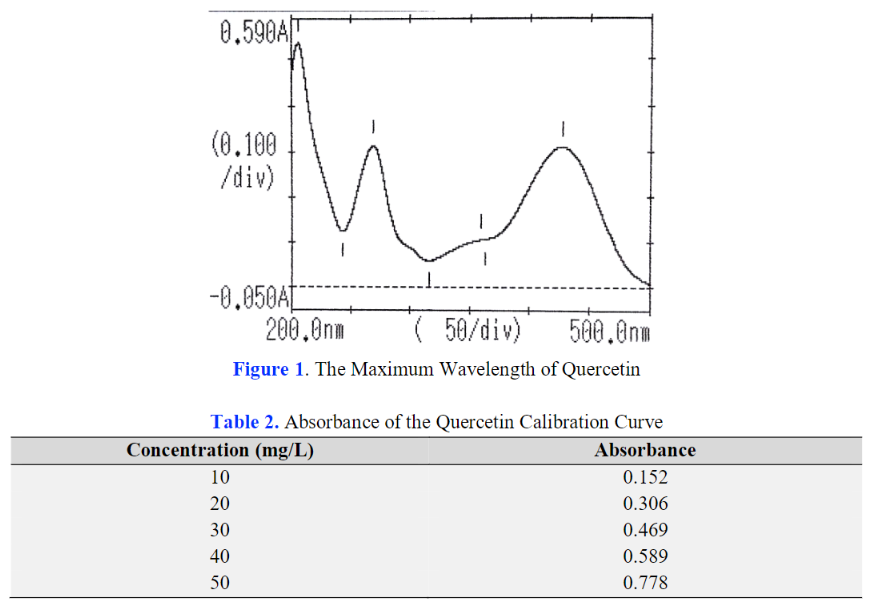Main Article Content
Abstract
The plants are rich sources of secondary metabolites, a bioactive compound that has various activities. Flavonoids, as a type of secondary metabolite, have been reported to possess anticancer, antioxidant, antibacterial, anti-inflammatory, and antiviral activities. Flavonoid has been found abundantly in Neem (Azadirachta indica Juss.) leaves. The difference in total flavonoid content might be an occurrence of the different solvent types and concentrations. The present study was conducted to analyze the phytochemical and determine the total flavonoid content of neem leaves extract using two different solvents (namely 70% ethanol and ethyl acetate) using UV-Vis spectrophotometric. The extraction from neem leaves was performed by maceration method. Phytochemical analysis of neem leaves reveals several secondary metabolites: flavonoids, steroids/triterpenoids, tannins, and saponins. Total flavonoid content from both extracts was determined by utilizing the UV-Vis spectrophotometric method at a maximum wavelength of 428.2 nm with three repetitions, and also quercetin was used as a standard. Total flavonoid content from neem leaves extract in solvents of 70% ethanol and ethyl acetate had a value of 118.57 ± 0.08 mg/g QE and 74.17 ± 0.20 mg/g QE, respectively. Neem leaves extract in solvents of 70% ethanol and ethyl acetate had identical phytochemical content. Total flavonoid content of neem leaves from 70% ethanol extract was higher than ethyl acetate extract.
Keywords
Article Details

This work is licensed under a Creative Commons Attribution-NonCommercial 4.0 International License.
References
- Aryal, S., Baniya, M. K., Danekhu, K., Kunwar, P., Gurung, R., & Koirala, N. (2019). Total Phenolic content, Flavonoid content and antioxidant potential of wild vegetables from western Nepal. Plants, 8(4). https://doi.org/10.3390/plants8040096.
- Ekin, S., Bayramoglu, M., Goktasoglu, A., Ozgokce, F., & Kiziltas, H. (2017). Antioxidant activity of aqueous and ethanol extracts of crataegus meyeri pojark leaves and contents of vitamin, trace element. Journal of the Chilean Chemical Society, 62(4), 3661–3667. https://doi.org/10.4067/s0717-97072017000403661.
- Fadillah, A., Rahmadani, A., & Rijai, L. (2017). Analisis Kadar Total Flavonoid Dan Uji Aktivitas Antioksidan Ekstrak Daun Kelubut (Passiflora foetida L.). Proceeding of the 5th Mulawarman Pharmaceuticals Conferences. 21–28. https://doi.org/10.25026/mpc.v5i1.217.
- Ilmiyah, N. H. (2019). Undergraduate Thesis. Uji aktivitas antibakteri ekstrak etanol 96% daun mimba (Azadirachta indica A. Juss.) dengan metode ekstraksi perkolasi terhadap pertumbuhan bakteri Staphylococcus aureus (+CD). Department of Pharmacy, Faculty of Medicine, Universitas Hang Tuah, Surabaya, Indonesia.
- Javandira, C., Widnyana, I. K., Suryadarmawan, I. G. A. (2016). Kajian fitokimia dan potensi ekstrak daun tanaman mimba (Azadiracta indica A. Juss.) sebagai pestisida nabati. Lembaga Penelitian dan Pemberdayaan Masyarakat (LPPM) UNMAS Denpasar. 402–406.
- Kamtekar, S., Keer, V., & Patil, V. (2014). Estimation of phenolic content, flavonoid content, antioxidant and alpha amylase inhibitory activity of marketed polyherbal formulation. Journal of Applied Pharmaceutical Science, 4(9), 61–65. https://doi.org/10.7324/JAPS.2014.40911.
- Mukhriani, Nonci, F. Y., & Munawarah, S. (2015). Analisis Kadar Flavonoid Total Pada Ekstrak Daun Sirsak (Annona muricata L.) Dengan Metode Spektrometri UV-Vis. JF FKIK UINAM, 3(2), 37–42.
- Niah, R., & Kumalasari, E. (2019). Profil Senyawa dan Aktivitas Antioksidan Ekstrak Daun Sepat (Mitragyna speciosa) dan Daun Dadangkak (Hydrolea spinosa L.). Jurnal Ilmiah Ibnu Sina (JIIS): Ilmu Farmasi Dan Kesehatan, 4(2), 391–399. https://doi.org/10.36387/jiis.v4i2.352.
- Panche, A. N., Diwan, A. D., & Chandra, S. R. (2016). Flavonoids: An overview. Journal of Nutritional Science, 5, E47. https://doi.org/10.1017/jns.2016.41.
- Pękal, A., & Pyrzynska, K. (2014). Evaluation of Aluminium Complexation Reaction for Flavonoid Content Assay. Food Analytical Methods, 7(9), 1776–1782. https://doi.org/10.1007/s12161-014-9814-x.
- Sembiring, E. N., Elya, B., Sauriasari, R., Sembiring, E. N., Elya, B., & Sauriasari, R. (2018). Phytochemical Screening, Total Flavonoid and Total Phenolic Content and Antioxidant Activity of Different Parts of Caesalpinia bonduc (L.) Roxb. Pharmacogn Journal, 10(1), 123–127.
- Senet, M. R. M., Parwata, I. M. O. A., & Sudiarta, I. W. (2017). Kandungan Total Fenol dan Flavonoid dari Buah Kersen (Muntingia calabura) serta Aktivitas Antioksidannya. Jurnal Kimia, 11(2): 187–193. https://doi.org/10.24843/jchem.2017.v11.i02.p14.
- Supriyanto, S., Simon, B. W., Rifa'i, M., & Yunianta, Y. (2017). Uji fitokimia dan aktivitas antioksidan ekstrak daun mimba (Azadiracta indica Juss.). Prosiding SNATIF, 4, 523–529.
- Supriyanto, S., Simon, B. W., Rifa’i, M., & Yunianta, Y. (2018). Aktivitas Antioksidan Fraksi Metanol Ekstrak Daun Mimba (Azardirachta indica Juss). Prosiding SENIATI, 3, 59–63.
- Syafitri, N. E., Bintang, M., & Falah, S. (2014). Kandungan Fitokimia, Total Fenol, dan Total Flavonoid Ekstrak Buah Harendong (Melastoma affine D. Don). Current Biochemistry, 1(3), 105–115.
- Wirasti. (2019). Penetapan Kadar Fenolik Total, Flavonoid Total, dan Uji Aktivitas Antioksidan Ekstrak Daun Benalu Petai (Scurrula atropurpurea Dans.) beserta Penapisan Fitokimia. Journal of Pharmaceutical and Medicinal Sciences, 4(1), 1–5. https://doi.org/10.32814/jpms.v4i1.73.
- Xu, D. P., Li, Y., Meng, X., Zhou, T., Zhou, Y., & Zheng, J. (2017). Zhang, -J.-J.; Li, H.-B. Natural Antioxidants in Foods and Medicinal Plants: Extraction, Assessment and Resources. Int. J. Mol. Sci, 18(1), 96
